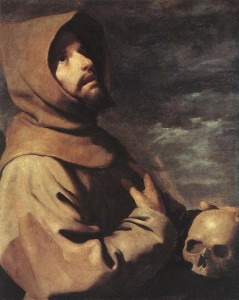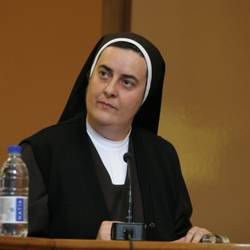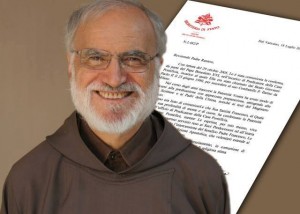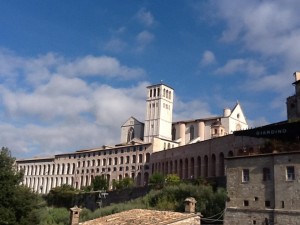Br. Roberto Genuin of the Province of Venice elected General Minister of the Friars Minor Capuchin. He was elected at the 85th General Chapter of the Order. Genuin succeeds Br. Mauro Jöhri of Switzerland. The term of office is six years.
Br. Roberto Genuin of the Province of Venice elected General Minister of the Friars Minor Capuchin. He was elected at the 85th General Chapter of the Order. Genuin succeeds Br. Mauro Jöhri of Switzerland. The term of office is six years.
 I’m always curious to where the various religious orders are in terms of ministry and the manpower. What can we extrapolate from the numbers and how is the charism lived? Next to the Society of Jesus the Order of Friars Minor are the most significant orders Mother Church has to preach the Gospel and to administer sacraments.
I’m always curious to where the various religious orders are in terms of ministry and the manpower. What can we extrapolate from the numbers and how is the charism lived? Next to the Society of Jesus the Order of Friars Minor are the most significant orders Mother Church has to preach the Gospel and to administer sacraments.
Prescinding what may be several institutional issues like faithfulness to the charism, orthodox teaching, authentic and holy life according to the mind of the founder, and the like, Franciscan friars have taken up the call to serve the Divine Master since the 13th century. The matter becomes: what difference does Jesus and the Church make in the lives of the friars? In the laity who follow the Saint Francis?
Franciscan Friar Father Dominic, a Franciscan historian stationed at St. Bonaventure University in Western New York, presented these facts:
The Order began the year 2015 with a membership of 13,632 friars. This is 113 friars fewer than the previous year, as the growth of the Order in the younger entities cannot yet compensate for the losses in Western Europe and North America. There are 11,794 solemnly professed friars, including 9,243 priests, 59 permanent deacons, 416 friars preparing for ordination, and 1957 lay friars. There was a slight increase of friars in initial formation — 1413 temporary professed and 425 novices. In terms of age, 34% of the world’s friars are under the age of 45, 29% between the ages of 45-64, and 37% over the age of 65.
A closer look at the Order’s six regions shows considerable divergence: four registered growth from the preceding year, whereas two — dominated by elderly friars — posted declines. These were Western Europe, with 3,999 friars, which was down 125 friars from the preceding year, and North America (the U.S. and Canada), with 1,273 friars, which was down 50. On the other hand, the other four regions of the Order showed growth: Latin America, with 3,334 friars, was up 20 friars; Africa, with 1,161 friars (up 30); Asia, with 1423 friars (up 5), and Eastern Europe, with 2442 friars (up 15). To illustrate the age difference among these entities: in the English-speaking Conference, for every friar under the age of 45, there are seven friars over 65. In Africa, on the other hand, the friars under the age of 45 outnumber the seniors 3 to 1.
Holy Name Province has now slipped to the eighth largest of the Order’s 125 entities. Just two years ago, it was fifth largest. The Province of Sts. Francis and James (Jalisco, Mexico) continues to be in first place with 472 friars (120 of whom are in initial formation) The Immaculate Conception Province (São Paolo, Brazil) follows, with 379 members (40 in formation). The third largest entity is now the Immaculate Conception Province (Krakow, Poland), with 338 friars, followed closely by the Province of the Holy Cross (Sarajevo, Bosnia) with 336 members. The German province (Munich) is fifth (322), and the Province of St. Anthony (Venice, Italy), is sixth (309). Slightly ahead of Holy Name (304 friars) is now the Assumption Province (Katowice, Poland) with 307 friars.
In terms of individual nations where the Order is present, Italy still has by far the greatest number of friars (2,038), followed by the United States (1,145), Poland (1,006), Mexico (990), and Brazil (950). It is interesting to note that these five countries comprise almost half the Franciscan friars in the world.
Holy Name, with 304 friars, continues to be the largest entity in the Order’s English-speaking Conference. The other provinces of the ESC are Sacred Heart, based in St. Louis, with 207 members; the Irish Province (which now includes Great Britain), 179; St. Barbara (based in Oakland, Calif.), 168; St. John the Baptist (Cincinnati), 147; Immaculate Conception (New York), 121; Assumption BVM (Franklin, Wis.), 111; St. Joseph (Montreal, Quebec), 68; Our Lady of Guadalupe (Albuquerque, N.M.), 57; Malta, 56; Lithuania, 42; and Christ the King (Edmonton, Alberta), with 33.
A video of the Franciscan Friars of the Immaculate
[credit: Rorate Caeli]
 I laughed and laughed and laughed this morning when I read the story of a criminal serving his sentence with Capuchin friars pleading to be sent back to prison… because Capuchin life is too hard, he claimed! The reason for the humor is that Capuchins aren’t too known for their austerities today in North America; the Capuchin order may be strict only in a few places in the world but…may be this is a wake up call to the Friars Minor Capuchin (and others)…
I laughed and laughed and laughed this morning when I read the story of a criminal serving his sentence with Capuchin friars pleading to be sent back to prison… because Capuchin life is too hard, he claimed! The reason for the humor is that Capuchins aren’t too known for their austerities today in North America; the Capuchin order may be strict only in a few places in the world but…may be this is a wake up call to the Friars Minor Capuchin (and others)…
I got this story via a friend:
Austere existence: A convicted criminal serving out his sentence in a Sicilian monastery run by Capuchin monks has escaped for the second time and asked to be sent back to prison because life there was too tough .
Thief David Catalano, 31, was sent to a Santa Maria degli Angeli community run by Capuchin monks in Sicily last November.
But he found their austere lifetstyle too tough to handle and soon escaped. After a short while on the run he was caught by police and sent back.
On Monday he fled for the second time in six weeks, only to swiftly turn himself in at a police station and beg officers to send him back to jail in the nearby town of Nicosia.
He told the stunned policemen: ‘Prison is better than being at that hostel run by monks.’
A police spokesman said: ‘Catalano arrived out of the blue and said there was no way he could stay on with the monks.
‘He said it was too tough and he wanted to go back to prison, so we happily obliged and he is now back behind bars serving the rest of his sentence.
‘Life with the monks can be pretty tough – there are no mod cons and they are up early and go to bed early. There are no luxuries at the hostel and the monks run a very austere regime.’
The Santa Maria degli Angeli community is based in a monastery near Enna on the island of Sicily.
‘He said it was too tough and he wanted to go back to prison, so we happily obliged and he is now back behind bars’
It has been run as a halfway house by the Capuchin friars for more than 12 years with around 60 prisoners accommodated there as they near the end of their sentences.
Requiem aeternam dona ei, Domine, et lux perpetua luceat ei. Requiescat in pace. Amen. Eternal rest grant unto him O Lord, and let perpetual light shin upon him.
A webpage dedicated to Father Benedict is posted here.
Rest in Peace Fr. Benedict.
 Sister Mary Melone, a Franciscan Sisters of Blessed Angelina, born in 1964, is the next Rector of the Faculty of Theology of the Pontifical University Antonianum. The venerable Antonianum is run by the Order of Friars Minor.
Sister Mary Melone, a Franciscan Sisters of Blessed Angelina, born in 1964, is the next Rector of the Faculty of Theology of the Pontifical University Antonianum. The venerable Antonianum is run by the Order of Friars Minor.
In recent history of this Roman pontifical university, Sister Melone is the first woman to be appointed a dean, and now the first woman to become a rector of a pontifical university in Rome. Cardinal Zenon Grocholewski, prefect of the Congregation for Catholic Education appointed Melone to a term lasting from 2014-2017. She is an expert on St. Anthony of Padua, and other points in Franciscan theology.
May Saint Anthony of Padua intercede for Sister Mary Melone’s intentions.
When Sr. Melone was elected the dean of the Antonianum she gave an interview to L’Osservatore Romano where she said:
The approach of a woman: “I don’t give much importance to these kinds of labels, female theology. Above all, I don’t like comparisons although I recognize that in the past there may have been a reason for making comparisons. Maybe there is one today as well, I don’t know. More space definitely needs to be given to women. The reference to female theology does not really fit with my vision of things: all that exists is theology. Theology as research, as a focus on mystery, as a reflection on this mystery. But precisely because this requires different sensitivities. A woman’s approach to mystery, the way in which she reflects on this mystery which offers itself and reveals itself, is certainly different from that of a man. But they do not contrast. I believe in theology and I believe that theology created by a woman is typical of a woman. It is different but without the element of laying claim to it. Otherwise it almost seems as though I am manipulating theology, when it is instead a field that requires honesty from the person who places him/herself before the mystery.”
More on women: “a reflection on this cannot be commensurate to the Church’s age as this reflects a development of thought that has gone on for hundreds of years. However, in my opinion a new space does exist and it is real. I also think it is irreversible, meaning that it is not a concession but a sign of the times from which there is no return. It is no pretense. I believe this depends a great deal on us women too. It is us who should get the ball rolling. Women cannot measure how much space they have in the Church in comparison to men: we have a space of our own, which is neither smaller nor greater than the space men occupy. It is our space. Thinking that we have to achieve what men have, will not get us anywhere. Of course, although the steps we take may be real, this does not mean the job is complete. A great deal more can be done but there is change, you can see it, feel it. I think that (my case aside) the election of a woman in a pontifical university is also proof this. The body who elected me was made up entirely of men!”
The Church does NOT need gender quotas? “No, it doesn’t need quotas, it needs collaboration. And collaboration needs to grow!”
In my opinion, the Franciscans of the Renewal (the friars and the sisters) are among a few very dynamic communities in the USA who are actually living the gospel and being formed by sacred Tradition. Their following and their belonging to Jesus Christ is out-of-this-world. I may be biased because of my friendship and experience with many of the CFRs, but I think you might say the say if you went to pray and work among them. A recent article on the CFRs speaks a little to their charism…
 The Secular Franciscan Order of Bethlehem are celebrating 125 years. Laity, according to their own context and vocation, are living the gospel and bringing the gospel message to the world. The SFO are living witnesses in imitation of Saint Francis of Assisi. The SFO provides personal formation to its members, education to youth, are present to the needs of the local church and assist in the Church Universal in a myriad of good works.
The Secular Franciscan Order of Bethlehem are celebrating 125 years. Laity, according to their own context and vocation, are living the gospel and bringing the gospel message to the world. The SFO are living witnesses in imitation of Saint Francis of Assisi. The SFO provides personal formation to its members, education to youth, are present to the needs of the local church and assist in the Church Universal in a myriad of good works.
Living in Bethlehem brings a unique due to the fact it’s the place where the Lord lived, died, rose from the dead and ascended to God the Father.
The Franciscan Media Center carried the story here.
The vocation to follow in the steps of Saint Francis of Assisi and the blessers and saints of the Order is available around the world. You can check locally to see about the presence of SFO. Each fraternity is unique and one may not have the same vigor as another. Following the Lord in this way is a rewarding way to know, love and serve Jesus.
 Capuchin Father Raniero Cantalamessa has been re-confirmed Preacher Apostolic by Pope Francis. A letter dated July 18, 2013 from the Vatican Secretary of State, Cardinal Tarcisio Bertone, Father Raniero of the decision by the Pope: “I now have the pleasure to inform you that his Holiness Pope Francis, who knows your depth of mind and heart, confirmed you as preacher of the Pontifical House.”
Capuchin Father Raniero Cantalamessa has been re-confirmed Preacher Apostolic by Pope Francis. A letter dated July 18, 2013 from the Vatican Secretary of State, Cardinal Tarcisio Bertone, Father Raniero of the decision by the Pope: “I now have the pleasure to inform you that his Holiness Pope Francis, who knows your depth of mind and heart, confirmed you as preacher of the Pontifical House.”
Friar Raniero was appointed preacher of the Pontifical House by Blessed John Paul II on June 23, 1980, He was subsequently re-confirmed by his successor, Pope Benedict XVI, October 29, 2005. Raniero is a member of the Province of the Marches in Italy.
You can visit the website of Raniero Cantalamessa published in Italian, English, German, French, Spanish and Portuguese at www.cantalamessa.org.
The office of Preacher Apostolic was established in 1555 by Pope Paul IV as one among many ways to reform the Roman Curia because the Preacher Apostolic would speak about theological matters as well as points of spiritual and ministerial discipline. Members of various religious families had the ministry of Preacher Apostolic until 2 March 1753 when Pope Benedict XIV gave the ministry perpetually to the Capuchin Franciscans. The Capuchin order was known then as a keen “example of Christian piety and religious perfection , the splendor of doctrine and Apostolic zeal.”
Father Raniero is a popular speaker and has authored several books.
 I give you thanks, Father, Lord of heaven and earth, for you have hidden these things from the wise and understanding, and revealed them to babes” (Mt 11:25).
I give you thanks, Father, Lord of heaven and earth, for you have hidden these things from the wise and understanding, and revealed them to babes” (Mt 11:25).
Peace and all good to each and every one of you! With this Franciscan greeting I thank you for being here, in this Square so full of history and faith, to pray together.
Today, I too have come, like countless other pilgrims, to give thanks to the Father for all that he wished to reveal to one of the “little ones” mentioned in today’s Gospel: Francis, the son of a wealthy merchant of Assisi. His encounter with Jesus led him to strip himself of an easy and carefree life in order to espouse “Lady Poverty” and to live as a true son of our heavenly Father. This decision of Saint Francis was a radical way of imitating Christ: he clothed himself anew, putting on Christ, who, though he was rich, became poor in order to make us rich by his poverty (cf. 2 Cor 8:9). In all of Francis’ life, love for the poor and the imitation of Christ in his poverty were inseparably united, like the two sides of a coin.
What does Saint Francis’s witness tell us today? What does he have to say to us, not merely with words – that is easy enough – but by his life?
1. His first and most essential witness is this: that being a Christian means having a living relationship with the person of Jesus; it means putting on Christ, being conformed to him.
Where did Francis’s journey to Christ begin? It began with the gaze of the crucified Jesus. With letting Jesus look at us at the very moment that he gives his life for us and draws us to himself. Francis experienced this in a special way in the Church of San Damiano, as he prayed before the cross which I too will have an opportunity to venerate. On that cross, Jesus is depicted not as dead, but alive! Blood is flowing from his wounded hands, feet and side, but that blood speaks of life. Jesus’ eyes are not closed but open, wide open: he looks at us in a way that touches our hearts. The cross does not speak to us about defeat and failure; paradoxically, it speaks to us about a death which is life, a death which gives life, for it speaks to us of love, the love of God incarnate, a love which does not die, but triumphs over evil and death. When we let the crucified Jesus gaze upon us, we are re-created, we become “a new creation”. Everything else starts with this: the experience of transforming grace, the experience of being loved for no merits of our own, in spite of our being sinners. That is why Saint Francis could say with Saint Paul: “Far be it for me to glory except in the cross of our Lord Jesus Christ” (Gal 6:14).
We turn to you, Francis, and we ask you: Teach us to remain before the cross, to let the crucified Christ gaze upon us, to let ourselves be forgiven, and recreated by his love.
2. In today’s Gospel we heard these words: “Come to me, all who labour and are heavy laden, and I will give you rest. Take my yoke upon you and learn from me, for I am gentle and lowly in heart” (Mt 11:28-29).
This is the second witness that Francis gives us: that everyone who follows Christ receives true peace, the peace that Christ alone can give, a peace which the world cannot give. Many people, when they think of Saint Francis, think of peace; very few people however go deeper. What is the peace which Francis received, experienced and lived, and which he passes on to us? It is the peace of Christ, which is born of the greatest love of all, the love of the cross. It is the peace which the Risen Jesus gave to his disciples when he stood in their midst and said: “Peace be with you!”, and in saying this, he showed them his wounded hands and his pierced side (cf. Jn 20:19-20).
Franciscan peace is not something saccharine. Hardly! That is not the real Saint Francis! Nor is it a kind of pantheistic harmony with forces of the cosmos… That is not Franciscan either; it is a notion some people have invented! The peace of Saint Francis is the peace of Christ, and it is found by those who “take up” their “yoke”, namely, Christ’s commandment: Love one another as I have loved you (cf. Jn 13:34; 15:12). This yoke cannot be borne with arrogance, presumption or pride, but only with meekness and humbleness of heart.
We turn to you, Francis, and we ask you: Teach us to be “instruments of peace”, of that peace which has its source in God, the peace which Jesus has brought us.
 3. “Praised may you be, Most High, All-powerful God, good Lord… by all your creatures (FF, 1820). This is the beginning of Saint Francis’s Canticle. Love for all creation, for its harmony. Saint Francis of Assisi bears witness to the need to respect all that God has created, and that men and women are called to safeguard and protect, but above all he bears witness to respect and love for every human being. God created the world to be a place where harmony and peace can flourish. Harmony and peace! Francis was a man of harmony and peace. From this City of Peace, I repeat with all the strength and the meekness of love: Let us respect creation, let us not be instruments of destruction! Let us respect each human being. May there be an end to armed conflicts which cover the earth with blood; may the clash of arms be silenced; and everywhere may hatred yield to love, injury to pardon, and discord to unity. Let us listen to the cry of all those who are weeping, who are suffering and who are dying because of violence, terrorism or war, in the Holy Land, so dear to Saint Francis, in Syria, throughout the Middle East and everywhere in the world.
3. “Praised may you be, Most High, All-powerful God, good Lord… by all your creatures (FF, 1820). This is the beginning of Saint Francis’s Canticle. Love for all creation, for its harmony. Saint Francis of Assisi bears witness to the need to respect all that God has created, and that men and women are called to safeguard and protect, but above all he bears witness to respect and love for every human being. God created the world to be a place where harmony and peace can flourish. Harmony and peace! Francis was a man of harmony and peace. From this City of Peace, I repeat with all the strength and the meekness of love: Let us respect creation, let us not be instruments of destruction! Let us respect each human being. May there be an end to armed conflicts which cover the earth with blood; may the clash of arms be silenced; and everywhere may hatred yield to love, injury to pardon, and discord to unity. Let us listen to the cry of all those who are weeping, who are suffering and who are dying because of violence, terrorism or war, in the Holy Land, so dear to Saint Francis, in Syria, throughout the Middle East and everywhere in the world.
We turn to you, Francis, and we ask you: Obtain for us God’s gift of harmony and peace in this our world!
Finally, I cannot forget the fact that today Italy celebrates Saint Francis as her patron saint. The traditional offering of oil for the votive lamp, which this year is given by the Region of Umbria, is an expression of this. Let us pray for Italy, that everyone will always work for the common good, and look more to what unites us, rather than what divides us.
I make my own the prayer of Saint Francis for Assisi, for Italy and for the world: “I pray to you, Lord Jesus Christ, Father of mercies: Do not look upon our ingratitude, but always keep in mind the surpassing goodness which you have shown to this City. Grant that it may always be the home of men and women who know you in truth and who glorify your most holy and glorious name, now and for all ages. Amen.” (The Mirror of Perfection, 124: FF, 1824).